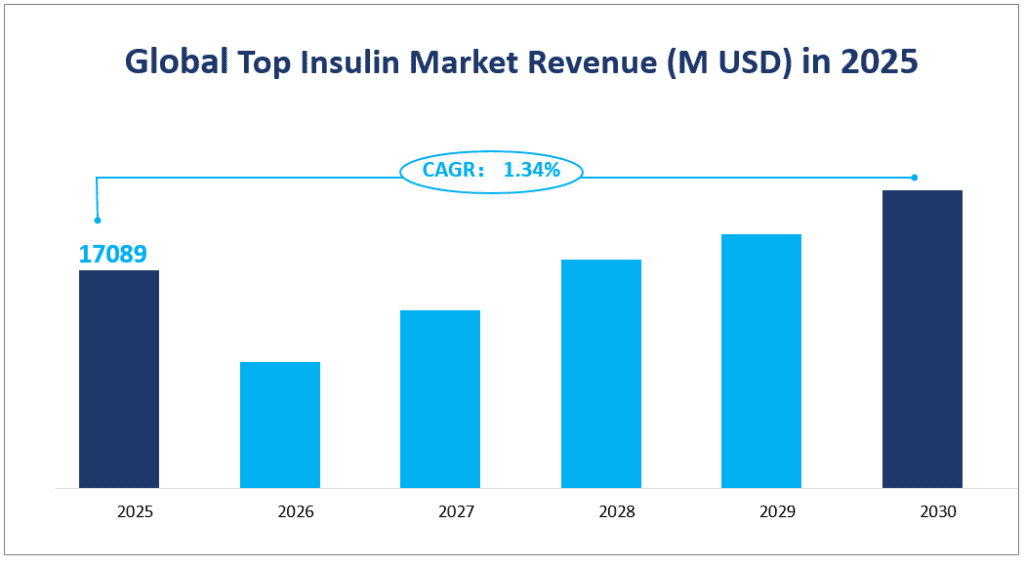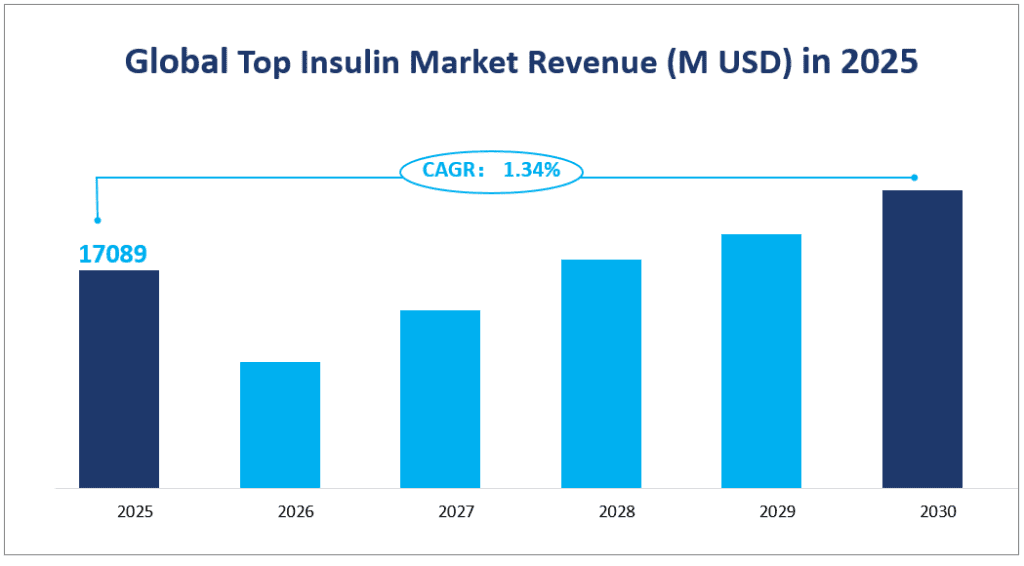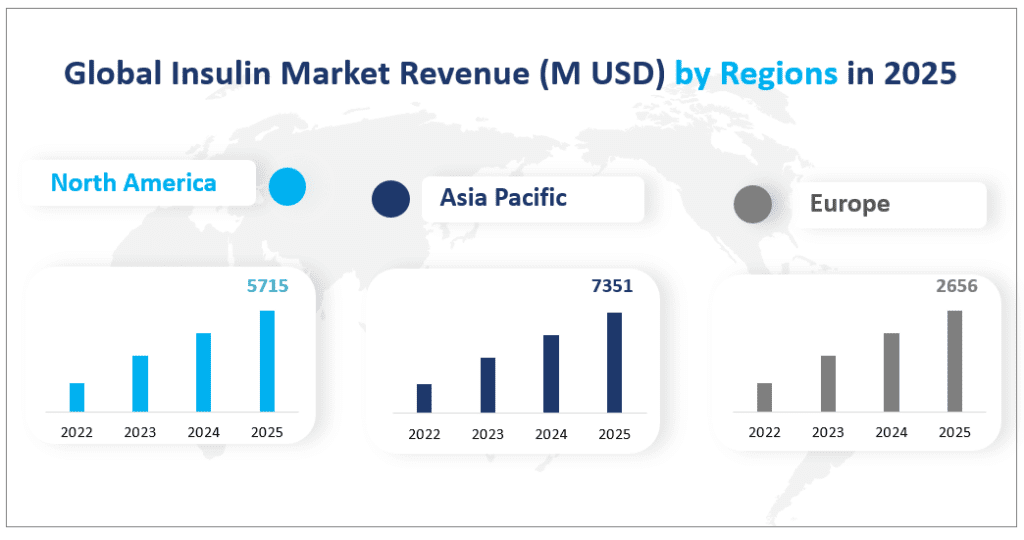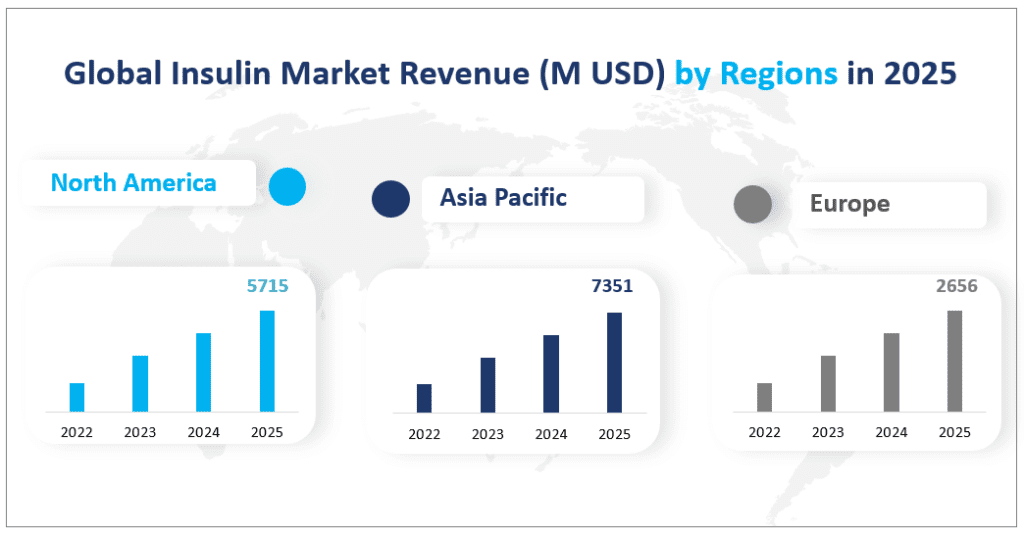1. Global Insulin Market Definition
The global insulin market revenue will reach $17089 million in 2025 with a CAGR of 1.34% from 2025 to 2030.
Insulin is a peptide hormone produced by the pancreatic beta cells. It regulates blood sugar levels by promoting the uptake of glucose into the liver, fat, and muscle cells. It helps maintain normal blood glucose levels and supports cellular growth and division. The insulin market is categorized based on product types, including Animal Insulin, Regular Human Insulin, and Insulin Analogues. Each type serves different therapeutic needs, with insulin analogs being the most prevalent due to their modified forms that alter the rate of absorption.
Global Top Insulin Market Revenue (M USD) in 2025


2. Driving Factors of Insulin Market
The growth of the global insulin market is influenced by a combination of driving and limiting factors. On the positive side, the rising prevalence of diabetes is a significant driver. Diabetes is one of the fastest-growing chronic diseases globally, with the International Diabetes Federation (IDF) estimating that approximately 643 million people will be living with diabetes by 2030, increasing to 783 million by 2045. This surge in diabetes cases, particularly in low- and middle-income countries, drives the demand for insulin products.
Another key driver is the continuous iteration and innovation in insulin formulations. Companies are investing heavily in research and development to create more effective and user-friendly insulin products. For example, Eli Lilly’s Mounjaro injection and Novo Nordisk’s Fiasp formulation represent advancements that improve patient outcomes and ease of use. Additionally, the development of non-injectable insulin forms, such as inhalable insulin (Afrezza) and oral insulin capsules (currently in Phase 3 trials), offers new avenues for market expansion
3. Limiting Factors of Insulin Market
However, the insulin market also faces several limiting factors. High technical barriers and production costs are significant challenges. Insulin production requires specialized knowledge, advanced technology, and strict quality control, making it difficult for new entrants to compete. The high cost of insulin analogs also places a financial burden on patients, limiting market accessibility.
Regulatory hurdles are another constraint. Insulin, being a protein polypeptide drug, must be administered via injection, and its approval process is highly regulated. The time-consuming nature of drug approvals can delay market entry and limit supply. Furthermore, device patent restrictions, such as those held by major players like Novo Nordisk and Sanofi, create barriers to competition. These patents protect insulin delivery devices, making it difficult for new entrants to develop compatible products.
4. Analysis of the Global Insulin Market Segment
Product Types
Animal insulin, derived from bovine or porcine sources, has been a traditional choice for diabetes management. In 2025, the revenue generated from animal insulin is expected to reach $147 million. While this type holds a niche market, its share is relatively small compared to other types. The market share of animal insulin is projected to be around 0.84% of the total insulin market revenue in 2025. The growth rate of animal insulin is relatively slow due to the increasing preference for human insulin and analogs, which offer better efficacy and fewer side effects.
Regular human insulin, produced using recombinant DNA technology, is a more modern alternative to animal insulin. In 2025, the revenue from regular human insulin is estimated to be $2419 million, accounting for approximately 8.28% of the total market revenue. This type of insulin is widely used due to its affordability and effectiveness. However, its market share is gradually declining as insulin analogs gain more popularity. The growth rate of regular human insulin is moderate, driven by its continued use in low- and middle-income countries where cost is a significant factor.
Insulin analogs represent the most advanced and fastest-growing segment of the insulin market. These synthetically modified forms of insulin offer better absorption rates and more precise blood sugar control. In 2025, insulin analogs are projected to generate a revenue of $14523 million, capturing a substantial 84.99% of the total market revenue. The rapid growth of insulin analogs is driven by their superior performance and the increasing demand from patients and healthcare providers. The growth rate of insulin analogs is the highest among all product types, reflecting their growing dominance in the market.
In summary, insulin analogs hold the largest market share in 2025. This dominance is attributed to their superior efficacy and the continuous innovation in their formulations. On the other hand, regular human insulin and animal insulin have smaller market shares, with regular human insulin holding 14.15% and animal insulin holding 0.86%. The fastest-growing product type is insulin analogs, driven by their advanced technology and better patient outcomes. Their growth rate significantly outpaces that of regular human insulin and animal insulin, making them the preferred choice for diabetes management.
Insulin Market by Application
Rapid-acting insulin, also known as ultra-short-acting insulin, is designed to act quickly and is typically used before meals. In 2025, the revenue from rapid-acting insulin is projected to reach $5203 million, accounting for approximately 30.44% of the total market revenue. This type of insulin is popular due to its quick onset of action, which helps in better postprandial glucose control. The growth rate of rapid-acting insulin is steady, driven by its essential role in diabetes management.
Short-acting insulin, which includes regular human insulin, is used to control blood sugar levels during meals. In 2025, the revenue from short-acting insulin is estimated to be $1190 million, representing around 6.96% of the total market revenue. This type of insulin is gradually being replaced by rapid-acting insulin in many cases, but it still holds a significant market share in certain regions. The growth rate of short-acting insulin is relatively slow, reflecting the shift towards more advanced insulin types.
Intermediate-acting insulin provides a longer duration of action compared to short-acting insulin. In 2025, the revenue from intermediate-acting insulin is projected to be $1276 million, accounting for approximately 7.47% of the total market revenue. This type of insulin is often used in combination with short-acting insulin to provide basal insulin coverage. The growth rate of intermediate-acting insulin is moderate, driven by its continued use in combination therapies.
Long-acting insulin, such as insulin glargine and insulin detemir, is designed to provide a steady release of insulin over an extended period. In 2025, the revenue from long-acting insulin is expected to reach $7261 million, capturing a significant 42.49% of the total market revenue. Long-acting insulin is crucial for maintaining stable blood sugar levels throughout the day and night. The growth rate of long-acting insulin is robust, driven by its essential role in basal insulin therapy and the increasing demand for better diabetes management.
Pre-mix insulin combines short-acting and intermediate-acting insulin in a single formulation, offering convenience for patients. In 2025, the revenue from pre-mix insulin is projected to be $2160 million, accounting for around 12.64% of the total market revenue. Pre-mix insulin is popular due to its ease of use and reduced injection frequency. The growth rate of pre-mix insulin is moderate, driven by its convenience and effectiveness in managing blood sugar levels.
In summary, long-acting insulin holds the largest market share in 2025. This dominance is attributed to its essential role in providing stable blood sugar control throughout the day. Rapid-acting insulin also holds a significant market share, reflecting its importance in postprandial glucose management. The fastest-growing application is long-acting insulin, driven by its critical role in basal insulin therapy and the increasing demand for better diabetes management. The growth rates of rapid-acting and pre-mix insulin are also notable, reflecting their essential roles in diabetes treatment.
Market Revenue and Share by Segment
| Market Revenue (M USD) in 2025 | Market Share in 2025 | ||
| By Type | Animal Insulin | 147 | 0.86% |
| Regular Human Insulin | 2419 | 14.15% | |
| Insulin Analogues | 14523 | 84.99% | |
| By Application | Rapid Acting | 5203 | 30.44% |
| Short Acting | 1190 | 6.96% | |
| Intermediate Acting | 1276 | 7.47% | |
| Long Acting | 7261 | 42.49% | |
| Pre-Mix Insulin | 2160 | 12.64% |
5. Regional Insulin Market
North America, comprising the United States and Canada, is a major player in the global insulin market. In 2025, the region is projected to generate a revenue of $5715 million. The United States, in particular, drives this revenue due to its high demand for advanced insulin products and strong healthcare infrastructure. The growth rate in North America is steady, supported by continuous innovation and high per capita healthcare expenditure.
Europe is another significant region in the insulin market, with a projected revenue of $2656 million in 202. Countries like Germany, France, and the UK contribute significantly to this revenue. The European market is characterized by a strong presence of key manufacturers and a high demand for insulin analogs. The growth rate in Europe is moderate, driven by increasing awareness and better healthcare policies.
The Asia Pacific region is the largest market for insulin, with a projected revenue of $7351 million in 2025. This region includes major economies like China, Japan, and India, which drive the demand for insulin due to their large patient populations and growing healthcare sectors. The growth rate in the Asia Pacific region is robust, driven by increasing diabetes prevalence and improving healthcare infrastructure. China alone contributes significantly to this revenue, making it a key market for insulin manufacturers.
Latin America, comprising countries like Mexico, Brazil, and Argentina, is projected to generate a revenue of $688 million in 2025, representing 4.05% of the global market. The region’s growth is driven by increasing diabetes prevalence and improving healthcare access. The growth rate in Latin America is relatively high, reflecting the region’s potential for market expansion.
The Middle East and Africa region is projected to generate a revenue of $679 million in 2025. Countries like Saudi Arabia, Turkey, and the UAE contribute significantly to this revenue. The growth rate in this region is moderate, driven by increasing awareness and improving healthcare infrastructure.
Global Insulin Market Revenue (M USD) by Regions in 2025


6. Analysis of the Top 3 Companies in the Global Insulin Market
Company Introduction and Business Overview:
Novo Nordisk is a global healthcare company founded in 1923, and headquartered in the United States. The company is renowned for its innovative and high-quality insulin products. Novo Nordisk’s business strategy focuses on continuous research and development to improve diabetes management solutions. The company’s strong market position is supported by its advanced manufacturing capabilities and global distribution network.
Products Offered:
Novo Nordisk offers a wide range of insulin products, including insulin analogues like Tresiba (insulin degludec) and Fiasp (insulin aspart). These products are designed to provide better blood sugar control and improved patient outcomes. The company also offers various delivery devices, such as insulin pens, to enhance patient convenience.
In 2023, Novo Nordisk’s insulin sales revenue was $7,453 million.
Company Introduction and Business Overview:
Sanofi-Aventis, founded in 2004 and headquartered in France, is a global biopharmaceutical company. The company is dedicated to improving human health through the development of innovative treatments and vaccines. Sanofi-Aventis has a strong presence in the insulin market, particularly with its long-acting insulin analogue, Lantus (insulin glargine).
Products Offered:
Sanofi-Aventis offers a range of insulin products, including Lantus, which is widely used for its long-acting properties. The company also offers other insulin formulations and delivery devices, contributing to its comprehensive diabetes management portfolio.
In 2023, Sanofi-Aventis’s insulin sales revenue was $4,394 million.
Company Introduction and Business Overview:
Eli Lilly, founded in 1876 and headquartered in the United States, is a leading global pharmaceutical company. The company is committed to improving human health through innovation and the development of high-quality medicines. Eli Lilly has a strong focus on diabetes management and offers a range of insulin products.
Products Offered:
Eli Lilly offers various insulin products, including Basaglar (insulin glargine) and Humalog (insulin lispro). The company’s products are designed to provide effective blood sugar control and improve patient outcomes. Eli Lilly also offers delivery devices and other diabetes management tools.
In 2023, Eli Lilly’s insulin sales revenue was $4,028 million.
Major Players
| Company | Headquarter | Market Distribution |
| Novo Nordisk | USA | Worldwide |
| Sanofi-Aventis | France | Worldwide |
| Eli Lilly | USA | Worldwide |
| Tonghua Dongbao | China | Worldwide |
| Ganlee | China | Worldwide |
| United Laboratory | China | Worldwide |
| Jiangsu Wanbang | China | Worldwide |
1 Study Coverage
1.1 Insulin Product Introduction
1.2 Insulin Type Introduction
1.3 Insulin Applications Introduction
1.4 Study Objectives
1.5 Years Considered
2 Executive Summary
2.1 Global Insulin Sales Estimates and Forecasts
2.2 Global Insulin Revenue Estimates and Forecasts 2018-2029
2.3 Global Insulin Revenue by Region: 2018 VS 2023 VS 2029
2.4 Global Top Insulin Regions by Sales
2.4.1 Global Top Insulin Regions by Sales (2018-2023)
2.4.2 Global Top Insulin Regions by Sales (2023-2029)
2.5 Global Top Insulin Regions by Revenue
2.5.1 Global Top Insulin Regions by Revenue (2018-2023)
2.5.2 Global Top Insulin Regions by Revenue (2023-2029)
2.6 North America
2.7 Europe
2.8 Asia Pacific
2.9 Latin America
2.10 Middle East & Africa
2.11 Global Insulin Sales /Price
3 Competition by Manufacturers
3.1 Insulin Sales by Manufacturers
3.1.1 Global Top Insulin Manufacturers by Sales (2018-2023)
3.1.2 Global Top Insulin Manufacturers Market Share by Sales (2018-2023)
3.1.3 Global Top 3 Companies by Insulin Sales in 2022
3.2 Insulin Revenue by Manufacturers
3.2.1 Global Top Insulin Manufacturers by Revenue (2018-2023)
3.2.2 Global Top Insulin Manufacturers Market Share by Revenue (2018-2023)
3.2.3 Global Top 3 Companies by Insulin Revenue in 2022
3.3 Global Insulin Sales Price by Manufacturers
3.4 Analysis of Competitive Landscape
3.4.1 Manufacturers Market Concentration Ratio (CR3 and HHI)
3.4.2 Global Insulin Manufacturers Headquarters and Founded Time
3.5 Mergers & Acquisitions, Expansion Plans
4 Market Size by Type
4.1 Global Insulin Sales by Type
4.1.1 Global Insulin Historical Sales by Type (2018-2023)
4.1.2 Global Insulin Forecasted Sales by Type (2023-2029)
4.1.3 Global Insulin Sales Market Share by Type (2018-2029)
4.2 Global Insulin Revenue by Type
4.2.1 Global Insulin Historical Revenue by Type (2018-2023)
4.2.2 Global Insulin Forecasted Revenue by Type (2023-2029)
4.2.3 Global Insulin Revenue Market Share by Type (2018-2029)
4.3 Global Insulin Price by Type
4.3.1 Global Insulin Price by Type (2018-2023)
4.3.2 Global Insulin Price Forecast by Type (2023-2029)
5 Market Size by Application
5.1 Global Insulin Sales by Application
5.1.1 Global Insulin Historical Sales by Application (2018-2023)
5.1.2 Global Insulin Forecasted Sales by Application (2023-2029)
5.1.3 Global Insulin Sales Market Share by Application (2018-2029)
5.2 Global Insulin Revenue by Application
5.2.1 Global Insulin Historical Revenue by Application (2018-2023)
5.2.2 Global Insulin Forecasted Revenue by Application (2023-2029)
5.2.3 Global Insulin Revenue Market Share by Application (2018-2029)
5.3 Global Insulin Price by Application
5.3.1 Global Insulin Price by Application (2018-2023)
5.3.2 Global Insulin Price Forecast by Application (2023-2029)
6 North America
6.1 North America Insulin Market Size by Type
6.1.1 North America Insulin Sales by Type (2018-2029)
6.1.2 North America Insulin Revenue by Type (2018-2029)
6.2 North America Insulin Market Size by Application
6.2.1 North America Insulin Sales by Application (2018-2029)
6.2.2 North America Insulin Revenue by Application (2018-2029)
6.3 North America Insulin Market Size by Country
6.3.1 North America Insulin Sales by Country (2018-2023)
6.3.2 North America Insulin Revenue by Country (2018-2023)
6.3.3 U.S.
6.3.4 Canada
7 Europe
7.1 Europe Insulin Market Size by Type
7.1.1 Europe Insulin Sales by Type (2018-2029)
7.1.2 Europe Insulin Revenue by Type (2018-2029)
7.2 Europe Insulin Market Size by Application
7.2.1 Europe Insulin Sales by Application (2018-2029)
7.2.2 Europe Insulin Revenue by Application (2018-2029)
7.3 Europe Insulin Market Size by Country
7.3.1 Europe Insulin Sales by Country (2018-2023)
7.3.2 Europe Insulin Revenue by Country (2018-2023)
7.3.3 Germany
7.3.4 France
7.3.5 U.K.
7.3.6 Italy
7.3.7 Russia
8 Asia Pacific
8.1 Asia Pacific Insulin Market Size by Type
8.1.1 Asia Pacific Insulin Sales by Type (2018-2029)
8.1.2 Asia Pacific Insulin Revenue by Type (2018-2029)
8.2 Asia Pacific Insulin Market Size by Application
8.2.1 Asia Pacific Insulin Sales by Application (2018-2029)
8.2.2 Asia Pacific Insulin Revenue by Application (2018-2029)
8.3 Asia Pacific Insulin Market Size by Country
8.3.1 Asia Pacific Insulin Sales by Country (2018-2023)
8.3.2 Asia Pacific Insulin Revenue by Country (2018-2023)
8.3.3 China
8.3.4 Japan
8.3.5 South Korea
8.3.6 India
8.3.7 Australia
8.3.8 Indonesia
8.3.9 Thailand
8.3.10 Malaysia
8.3.11 Philippines
8.3.12 Vietnam
9 Latin America
9.1 Latin America Insulin Market Size by Type
9.1.1 Latin America Insulin Sales by Type (2018-2029)
9.1.2 Latin America Insulin Revenue by Type (2018-2029)
9.2 Latin America Insulin Market Size by Application
9.2.1 Latin America Insulin Sales by Application (2018-2029)
9.2.2 Latin America Insulin Revenue by Application (2018-2029)
9.3 Latin America Insulin Market Size by Country
9.3.1 Latin America Insulin Sales by Country (2018-2023)
9.3.2 Latin America Insulin Revenue by Country (2018-2023)
9.3.3 Mexico
9.3.4 Brazil
9.3.5 Argentina
10 Middle East and Africa
10.1 Middle East and Africa Insulin Market Size by Type
10.1.1 Middle East and Africa Insulin Sales by Type (2018-2029)
10.1.2 Middle East and Africa Insulin Revenue by Type (2018-2029)
10.2 Middle East and Africa Insulin Market Size by Application
10.2.1 Middle East and Africa Insulin Sales by Application (2018-2029)
10.2.2 Middle East and Africa Insulin Revenue by Application (2018-2029)
10.3 Middle East and Africa Insulin Market Size by Country
10.3.1 Middle East and Africa Insulin Sales by Country (2018-2023)
10.3.2 Middle East and Africa Insulin Revenue by Country (2018-2023)
10.3.3 Turkey
10.3.4 Saudi Arabia
10.3.5 U.A.E
11 Corporate Profile
11.1 Novo Nordisk
11.1.1 Company Corporation Information
11.1.2 Product Overview
11.1.3 Novo Nordisk Insulin Sales, Price, Revenue, Gross Margin
11.1.4 Related Developments/ Business Overview
11.2 Sanofi-Aventis
11.2.1 Company Corporation Information
11.2.2 Product Overview
11.2.3 Sanofi-Aventis Insulin Sales, Price, Revenue, Gross Margin
11.2.4 Related Developments/ Business Overview
11.3 Eli Lilly
11.3.1 Company Corporation Information
11.3.2 Product Overview
11.3.3 Eli Lilly Insulin Sales, Price, Revenue, Gross Margin
11.3.4 Related Developments/ Business Overview
11.4 Tonghua Dongbao
11.4.1 Company Corporation Information
11.4.2 Product Overview
11.4.3 Tonghua Dongbao Insulin Sales, Price, Revenue, Gross Margin
11.4.4 Related Developments/ Business Overview
11.5 Ganlee
11.5.1 Company Corporation Information
11.5.2 Product Overview
11.5.3 Ganlee Insulin Sales, Price, Revenue, Gross Margin
11.5.4 Related Developments/ Business Overview
11.6 United Laboratory
11.6.1 Company Corporation Information
11.6.2 Product Overview
11.6.3 United Laboratory Insulin Sales, Price, Revenue, Gross Margin
11.6.4 Related Developments/ Business Overview
11.7 Jiangsu Wanbang
11.7.1 Company Corporation Information
11.7.2 Product Overview
11.7.3 Jiangsu Wanbang Insulin Sales, Price, Revenue, Gross Margin
11.7.4 Related Developments/ Business Overview
12 Value Chain and Sales Channels Analysis
12.1 Insulin Value Chain Analysis
12.2 Insulin Key Raw Materials
12.2.1 Key Raw Materials
12.2.2 Raw Materials Key Suppliers
12.3 Insulin Production Mode & Process
12.4 Insulin Sales and Marketing
12.4.1 Insulin Sales Channels
12.4.1.1 Direct Channel
12.4.1.2 Indirect Channel
12.4.2 Insulin Distributors
12.5 Insulin Customers
13 Market Trends, Drivers, Challenges and Restraints Factors Analysis
13.1 Insulin Industry Trends
13.2 Insulin Market Drivers
13.3 Insulin Market Challenges and Restraints
14 Key Findings in The Global Insulin Study
15 Appendix
15.1 Methodology
15.2 Research Data Source
15.2.1 Secondary Data
15.2.2 Primary Data
15.2.3 Market Size Estimation
15.2.4 Legal Disclaimer
